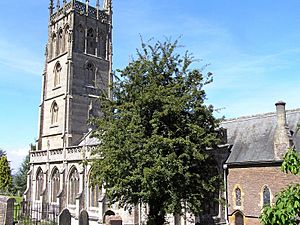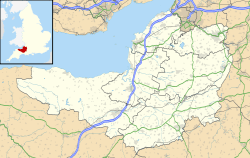Church of St James, Winscombe facts for kids
Quick facts for kids Church of St James |
|
|---|---|
 |
|
| 51°18′21″N 2°50′44″W / 51.305913°N 2.845658°W | |
| Location | Winscombe, Somerset |
| Country | England |
| Denomination | Church of England |
| Churchmanship | Central |
| History | |
| Status | Active |
| Dedication | St James the Great |
| Consecrated | 26 August 1236 |
| Architecture | |
| Functional status | Parish church |
| Heritage designation | Grade I |
| Designated | 9 February 1961 |
| Completed | 15th century |
| Administration | |
| Parish | Winscombe and Sandford |
| Archdeaconry | Archdeaconry of Bath |
| Diocese | Diocese of Bath and Wells |
The Church of St James is a historic church located in Winscombe, Somerset, England. While parts of the church date back to the 12th or 13th century, most of the building you see today was built in the 15th century. It is considered a very important historical building and is listed as a Grade I listed building.
Contents
Church History and Design
The Church of St James has a long and interesting past. Although there are no records left of the original Norman church, some older parts still exist. For example, the font (a basin used for baptisms) and a single narrow window are from that early period.
Early Beginnings
An old document, called a Deed of Gift, confirms that the church was officially opened by Bishop Jocelin on August 26, 1236. Three years later, he gave the church to the Dean and Chapter of Wells Cathedral. This meant it became part of the larger church organization in the area.
Tower and Stained Glass
Around 1435, a tall, impressive tower was added to the church. This tower is about 100 feet (30 meters) high and is known for being one of the most elegant towers in Somerset. It was built by Bishop John Harewell. At the same time, beautiful stained glass windows were also installed, adding colorful light to the church.
Victorian Updates
In 1863, the church underwent a major restoration. A new chancel, which is the part of the church near the altar, was added. This work was done by a famous architect named William Burges. He also designed three stained-glass lancet windows for the chancel. These windows were created in memory of the mother of the local vicar, John Augustus Yatman.
The quality of these windows was highly praised by art experts. They show a mix of old medieval styles and newer Renaissance art. There are also older medieval glass windows in other parts of the church, including a side chapel and near the organ.
Church Bells
The bells of St James have been calling people to worship for many years. The first bells were made in 1773 by a local family of bell founders, the Bilbie family. Later, in 1903, two more bells were added by Taylors Founders.
Today, the church has eight bells. They are tuned to the key of E flat. The largest bell, called the tenor, weighs about 930 kilograms (which is about 18 hundredweight). These bells are still used regularly for services on Sundays, ringing out for both the morning service and evensong.
See also
- List of Grade I listed buildings in North Somerset
- List of towers in Somerset
- List of ecclesiastical parishes in the Diocese of Bath and Wells


